Section 3: Intimate partner violence
By Maire Sinha
- Intimate partner violence accounts for one-quarter of all police-reported violent crimes
- Rates of intimate partner violence highest among young Canadians
- Victims of spousal violence younger than dating violence victims
- Two-thirds of intimate partner violence victims were victimized by a current partner
- Women at heightened risk of spousal homicide after marital separation
- Rates of spousal homicides higher in common-law unions than legal marriages
- Common assault accounts for highest share of intimate partner violence
- Most accused used their own physical force rather than weapons
- Formal charges pursued in most incidents of intimate partner violence
- Intimate partner homicides stable in recent years
- Decrease in common assault against intimate partners
- Saskatchewan and Manitoba record highest rates of intimate partner violence
- Summary
- Detailed data tables
- References
- Notes
Intimate partner violence ranges from emotional abuse, such as name calling, to repeated physical or sexual assaults and homicide (Heise and Garcia-Moreno 2002). Recognized as a public health issue, intimate partner violence can have far-reaching consequences on not only the direct victim, but also on families, communities and society at large. A recent Justice Canada study estimated the cost of one type of intimate partner violence, spousal violence, on Canadian society at $7.4 billion in 2009 (Zhang et al. 2013). Most of these costs were related to victim costs, such as pain and suffering, counselling expenses and legal fees for divorce, while the next highest costs were borne by third parties (e.g., families, employers and social services) and the criminal and civil justice systems (e.g., police, courts, corrections).
For the purposes of this section, police-reported data are used to examine the prevalence and nature of intimate partner violence coming to the attention of police in Canada. Intimate partner violence is defined as violence perpetrated against spouses and dating partners, either in current or former relationships. Whenever possible, the analysis of police-reported data delineates any differences between spousal and dating violence, while recognizing that these forms of violence often share a number of similarities, such as the victim's potential emotional attachment to the abuser and the possible recurring nature of the violence.
All Criminal Code violent violations reported to and substantiated by police are included in this analysis. Not included are those violent incidents that do not reach the attention of police, which according to the General Social Survey on victimization, represented about three-quarters of all self-reported spousal victims in 2009 (Brennan 2011).Note 1 Overall, unreported incidents were generally less severe and less likely to involve physical injury, compared to those incidents of spousal violence that came to the attention of police (Sinha 2013). Acts of financial and emotional abuse that do not reach the criminal thresholdNote 2 are also outside the scope of the current analysis.
Intimate partner violence accounts for one-quarter of all police-reported violent crimes
Intimate partner violence, including both spousal and dating violence, accounts for one in every four violent crimes reported to police. In 2011, there were approximately 97,500 victims of intimate partner violence, representing a rate of 341 victims per 100,000 population (Table 3.1). The vast majority of these victims (80%) were women, a finding consistent over time.Note 3
Overall, violence against dating partners was more prevalent than spousal violence, with a rate that was at least 1.6 times greater than the rate for spousesNote 4 (408 per 100,000 population versus 250 per 100,000).Note 5
Violence by a dating partner was more prevalent than violence committed by any other type of perpetrator, including one of the most common – friends or acquaintances. In particular, the rate of violence by a dating partner was 10% higher than the rate of violence committed by friends or acquaintances, 42% higher than stranger violence and nearly three times higher than non-spousal family violence.
These findings held true for females but were not consistently the case for males. That is, while males were also more likely to be a victim of police-reported dating violence than of spousal violence, males were much more likely to be the victim of violence perpetrated by friends, acquaintances or strangers.
Start of text box 3.1
Text box 3.1How intimate partner violence is measured
One challenge in measuring the relative prevalence of spousal and dating partner violence is the calculation of rates. In general, rates are calculated by dividing the number of occurrences of a particular type of incident by the population at risk of that type of incident. To accurately calculate rates, it is necessary to first determine the population that best reflects the population at risk.
For spousal violence, data on the at-risk population are available and include those legally married, separated, divorced and in a common-law relationship. One limitation, however, is the absence of population data for those individuals who were in a previous common-law relationship, as this information is not captured within the Census.
For dating violence, the at-risk population are those currently dating or had been in a dating relationship. No estimate of this population exists (i.e., number of current and former dating partners). As a result, the best approximate at-risk population would be those persons who are currently unmarried, including single, separated, divorced and widowed persons.
Calculating a dating violence rate using the total unmarried population underestimates the actual prevalence of dating violence, since the number of incidents of dating violence is being divided by a population that is larger than the true dating population. In other words, the rate of dating violence would be higher if it was calculated based on the actual population of dating partners. For this reason, any comparison of rates of spousal violence and dating partner violence should be made with caution.
Calculating rates among particular types of intimate partner unions, such as common-law and legally married unions, as well as specific relationship statuses, namely current versus previous partnership, is limited to the Homicide Survey. This is because the accused-victim relationship categories within the Incident-based UCR Survey do not match population data. For homicides, it is possible to calculate rates using the at-risk population for legally married spouses, divorced spouses, and current common-law spouses. Disaggregated population data do not exist for previous common-law partners, current dating partners, previous dating partners, current same-sex spouses, and previous same-sex spouses.
End of text box 3.1
Rates of intimate partner violence highest among young Canadians
As with violent crime overall, young Canadians were most often the victim of intimate partner violence. Women and men in their late 20s and early 30s had the highest rates of intimate partner violent victimization per 100,000 population, followed closely by those aged 15 to 24 years (Chart 3.1). Rates generally declined with increasing age and were higher for women in every age group.
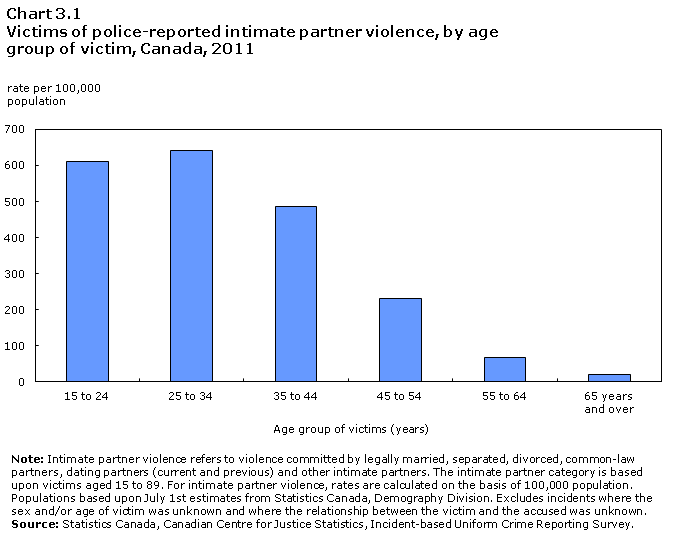
Somewhat different findings emerged when intimate partner violence escalated to homicide and this was the case for both women and men. Those aged 25 to 34 years remained at highest risk. However the second highest risk of being killed by their intimate partner was for those in their late thirties to early forties. This was followed by those aged 45 to 54. The youngest age-cohort, those aged 15 to 24, experienced a rate of intimate partner homicide that was similar to older Canadians.
Victims of spousal violence younger than dating violence victims
According to police-reported data, there were clear variations between spousal and dating violence, with victims of spousal violence being younger than dating violence victims. In particular, rates of spousal violence, including spousal homicide, were highest among women and men aged 15 to 24, with rates falling with each increasing age cohort (Table 3.2; Chart 3.2).
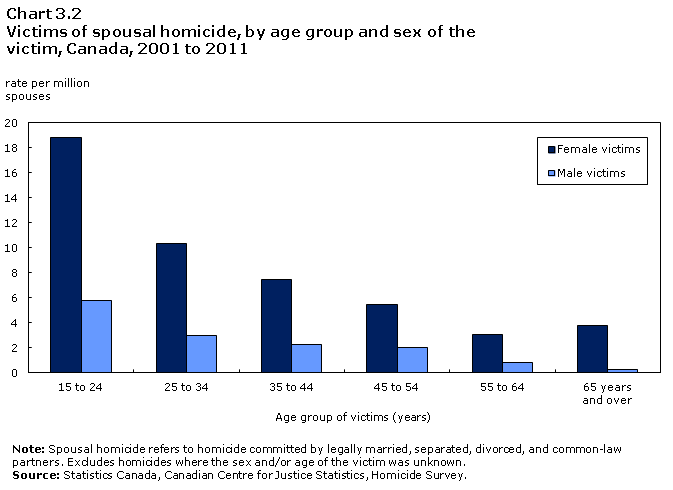
By contrast, Canadians aged 25 to 34, along with those aged 35 to 44, experienced the highest overall rates of dating violence per 100,000 unmarried persons (Table 3.3). In fact, when dating violence culminated in homicides, victims were even older, with the risk being highest among Canadians aged 35 to 44. (Chart 3.3).Note 6

It is important to note that not all types of dating violence were more prevalent among older aged victims. In particular, the risk of sexually-based crimes was highest for those aged 15 to 24 and dropped with increasing age. Also, although overall rates of dating violence based on the unmarried population were more elevated among older age cohorts, the number of dating violence victims based on the total population was highest among the youngest age group - those aged 15 to 24 (40%). This reflects the fact that dating relationships are highest among young people, and decline with age, as more individuals marry or move into common-law relationships. In other words, as individuals age, there are fewer persons identified as unmarried and therefore, the at-risk population of unmarried persons diminishes with age.
Two-thirds of intimate partner violence victims were victimized by a current partner
Previous research suggests that intimate partner violence often continues, escalates or even begins after the dissolution of a relationship (Johnson 2006; Johnson and Hotton 2003; Hotton 2001). Police-reported data indicate that about 26,600 women and 6,600 men experienced post-separation violence in 2011. This type of violence was proportionally less common than violence against current partners. In 2011, 34% of all police-reported intimate partner victims were violently victimized by their previous partner, compared to 65% by a current partner.Note 7 This pattern held true for both female and male victims.
The lower representation of previous partners as intimate partner victims was seen for both spousal and dating violence. That said, dating violence victims were slightly more likely than spousal victims to be estranged from their partner at the time of the violent incident (38% versus 30%).
Women at heightened risk of spousal homicide after marital separation
Although violent incidents against current intimate partners outnumber those against previous partners, these figures do not control for differences in the size of the current and previously partnered population. While it is not possible to calculate rates for current or previous partners based on the Incident-based UCR Survey,Note 8 the Homicide Survey can be used to calculate rates based on the at-risk populations.Note 9
As with spousal violence overall, the actual number of individuals killed by a current spouse was higher than those killed by a legally separated spouse. However, when expressed as a rate, the prevalence of spousal homicide was highest after marital separation, though only for women. In particular, over the past five years from 2007 to 2011, a woman's risk of being killed by a legally separated spouse was nearly six times higher than their risk from a legally married spouse (Chart 3.4).Note 10 Jealousy of the female victim was more often a factor in homicides of legally separated spouses (25%) over this period, compared to homicides involving women married at the time of the incident (12%). That said, frustration was the leading motive behind both (47% and 41%).
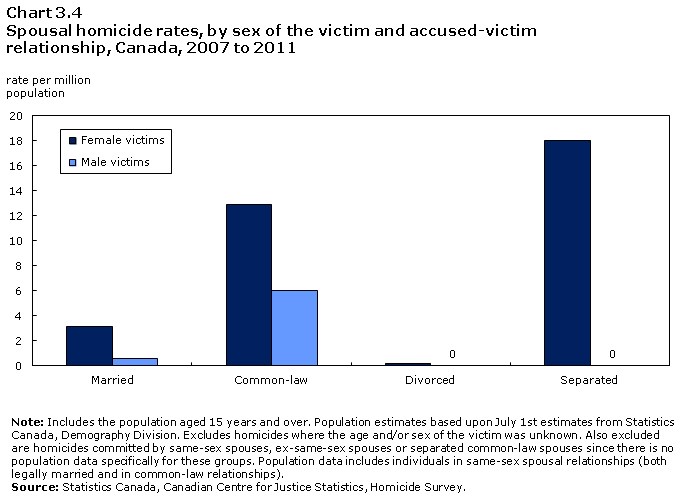
Over the same five-year period (2007 to 2011), no men were killed by their separated or divorced spouse and one male victim per million married men was killed by their current spouse. For women, rates of spousal homicide were lowest among the divorced population.
Unlike spousal homicide, rates of dating homicide cannot account for differences in the population of individuals currently dating versus those previously dating. However, similar to spousal homicides of women, jealousy was more often a motive in homicides against previous dating partners over the past five years, compared to homicides against current dating partners (29% versus 16%).
Rates of spousal homicides higher in common-law unions than legal marriages
In recent years, common-law couples have become increasingly more prevalent, while married couples are declining as a proportion of all families in Canada (Statistics Canada 2012). Previous research has suggested that individuals in common-law unions are at higher risk of spousal violence, because of factors related to young age and lower socio-economic status (Johnson 2006).
Findings from the Homicide Survey confirm that the risk of spousal homicide was elevated among women and men currently living in a common-law union.Note 11 Between 2007 and 2011, women were four times more likely to be killed by their common-law partner than by their legally married spouse (13 victims per million population versus 3 victims per million) (Chart 3.4). Similarly, men in common-law unions were ten times more likely than their married counterparts to be killed by their partners (6 victims per million versus 1 victim per million).
Overall, individuals in common-law unions were more often than their legally married counterparts to be killed because of an escalation of an argument (60% versus 27%) or as a result of the partner's jealousy (17% and 11%). Frustration was a less common motivating factor in homicides of common-law partners than those involving legally married spouses (14% and 37%).
Common assault accounts for highest share of intimate partner violence
In keeping with previous findings, the majority of victims of intimate partner violence were physically assaulted in some way. More specifically, three in four victims of intimate partner violence were victims of physical assaults, most of which (81%) were common assaults, an offence with little to no injury to the victim (Table 3.4). After physical assaults, the next most common offences against intimate partners were uttering threats at 9% and criminal harassment at 7%.
While the type of offences committed against women and men were generally similar, there were a few exceptions. For instance, major assault was more prevalent among male victims of intimate partner violence than female victims (20% versus 11%), perhaps reflecting the greater tendency of intimate partner violence against men to involve weapons (22% versus 11% of incidents against women). On the other hand, sexual offences and criminal harassment occurred more frequently against female victims than male victims of intimate partner violence.
For both sexes, there was some variation in the types of offences perpetrated against spousal and dating violence victims. Most notably, a slightly higher proportion of spousal victims were physically assaulted compared to dating violence victims (76% versus 72%). Even greater differences in the types of offences were evident between individuals in a current relationship and those whose relationship had ended. In particular, almost nine in ten victims of violence by a current spouse or dating partner were physically assaulted, while the same was true for 48% of victims by a previous partner (Chart 3.5).
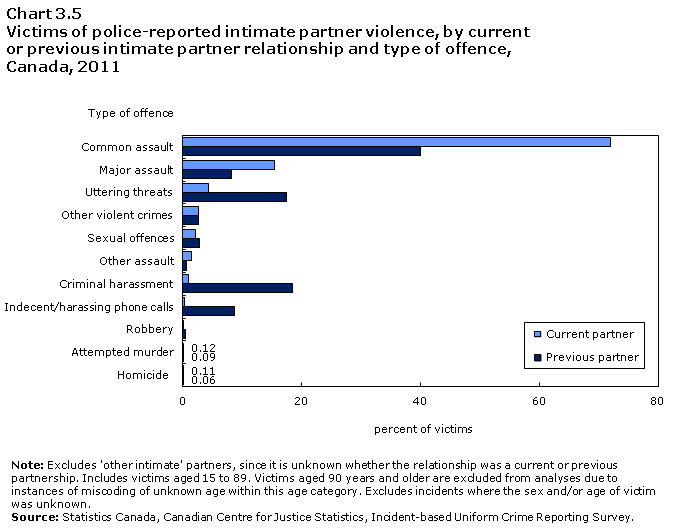
Also, compared to violence by a current partner, violence by a past partner was nearly eight times more likely to involve intimidation offences, namely criminal harassment, indecent phone calls and uttering threats (45% versus 6%). This finding may not be unexpected given that the nature of intimidation offences is more indicative of actions of accused who are estranged and not living with their partner, rather than those who have close physical contact with the victim.
Most accused used their own physical force rather than weapons
Patterns in weapon use and injury largely reflect the fact that common assault was the predominant offence against intimate partners. In the majority of incidents (70%), the perpetrator used their own physical force, rather than a weapon, to either threaten or cause injury to the victim (Table 3.5). Another 13% of incidents involved the use of a weapon, while in 17% of incidents, no weapon was used.
As previously noted, a larger share of incidents against male intimate partners involved a weapon compared to those against a female intimate partner (22% versus 11%). It has been suggested that female aggressors are more likely to wield a weapon because of gender differences in physical strength (Busch and Rosenberg 2004).
Given the greater use of weapons against men and the higher tendency for injury among incidents involving weapons,Note 12 male victims were slightly more likely than female victims to suffer physical injury (55% versus 52%). Minor injuries accounted for this gender difference , with 53% of male victims sustaining minor physical injuries and 50% of female victims. There was no gender difference in major injury or death, as male and female victims of intimate partner violence were equally as likely to either die or experience a physical injury requiring professional medical attention (2% each).
Dating violence victims were slightly more likely than spousal violence victims to suffer from injuries (54% versus 50%). This is despite the finding that there was little difference in weapon use or type of offence between dating and spousal violence incidents.
Formal charges pursued in most incidents of intimate partner violence
Pro-charging policies were introduced in the 1980s to help prevent and respond to spousal violence (Garner and Maxwell 2009). Every Canadian jurisdiction has implemented some form of pro-charging policies, which require that charges be laid in cases of intimate partner violence, where there are reasonable grounds to believe an offence has been committed.Note 13 This is, in fact, the applicable standard for all criminal conduct.
In 2011, 71% of intimate partner violence incidents reported to police resulted in a criminal charge being laid or recommended against the accused (Table 3.6). This was almost double the proportion recorded for non-intimate partner violence (39%), which includes violence perpetrated by accused known to the victim (e.g., casual acquaintances), as well as strangers. Among intimate partner violence incidents, 16% were cleared by means other than a charge.Note 14 The most common reason for clearing the incident through other means included a request by the complainant not to lay charges, reasons beyond the control of the department, and departmental discretion.
Overall, female victims of intimate partner violence were more likely than male victims to see charges laid or recommended (74% versus 61%). There was virtually no difference in the proportion of spousal and dating violence incidents ending in charges against the accused (72% and 71%).
Intimate partner homicides stable in recent years
Trends in police-reported intimate partner violence can be assessed using data from both the Homicide Survey and the Incident-based UCR Survey. Generally considered a country's barometer of violent crime,Note 15 homicides, which are less prone to issues of under-reporting to police, can signal shifts in the prevalence of intimate partner violence over time. In the 1990s, homicides involving intimate partners dropped by more than half, from a rate of 6.7 victims per million in 1991 to a rate of 3.7 per million in 1999 (Chart 3.6).Note 16 Since then, the decreases have been less dramatic, but the rate in 2011 remained lower (-24%) than a decade earlier. For the third year in a row, the overall rate of intimate partner homicide held steady at 3.1 victims per million.
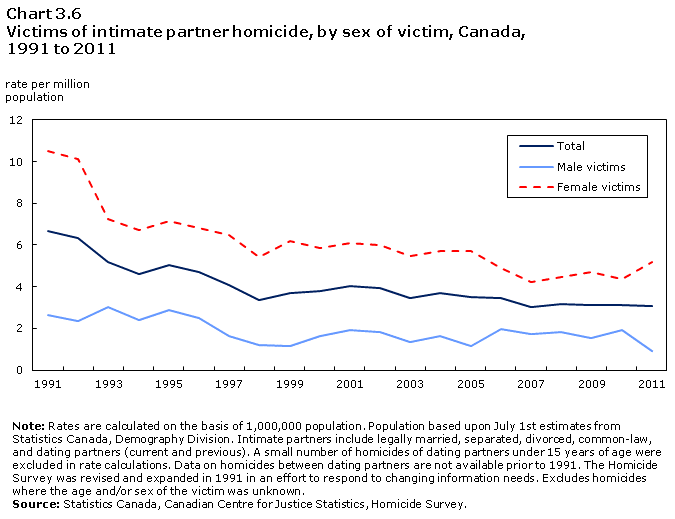
The most recent stability in rates of intimate partner homicides over the last three years was not evident for both sexes, and in fact, resulted from an increase in rates of intimate partner homicides against women and a concurrent decrease in rates against men. In 2011, the rate of intimate partner homicides against women grew by 19% from a rate of 4.4 victims per million women in 2010 to 5.2 victims per million women in 2011. Increases were seen in both spousal homicides (+21%) and dating homicides (+12%) (Table 3.7, Table 3.8). In contrast, the male rate of intimate partner homicides fell in 2011 to the lowest rate recorded in the previous twenty-year period. Both homicides against male spouses and dating partners decreased.
Decrease in common assault against intimate partners
According to police-reported data, the most frequently occurring type of offence against intimate partners – common assault - has decreased in recent years. Between 2009 and 2011, the rate of common assault fell by 4%, which was entirely driven by a drop in assaults against female intimate partners, the majority of victims of intimate partner violenceNote 17 (Table 3.9). Rates of common assault against male intimate partners remained stable throughout this period. It is unclear whether the decrease in common assaults against women reflect actual changes in the incidence of this type of intimate partner violence or changes in the willingness of victims to report these crimes to police.Note 18
For both men and women, rates of serious assaults against intimate partners, including aggravated assault and aggravated assault with a weapon or causing bodily harm, held steady between 2009 and 2011. Characterized by little to no physical injury, rates of level 1 sexual assaults involving intimate partners increased 5% for men and 13% for women between 2009 and 2011. More serious sexual assaults, however, were relatively stable against male intimate partners and decreased 7% for female intimate partners.
Overall, attempted murders of intimate partners dropped 12% between 2009 and 2011. As with common assaults, this decrease was primarily fueled by fewer attempted murders of female intimate partners per 100,000 population, as rates of attempted murder against male intimate partners decreased slightly (-2%).
Saskatchewan and Manitoba record highest rates of intimate partner violence
Regional variations in intimate partner violence generally mirror those of violent crime overall. Among the provinces, Saskatchewan had the highest rate of intimate partner violence, with a rate that was 30% higher than the next highest rate recorded by Manitoba (Chart 3.7, Table 3.10). The lowest rates were in Ontario and Quebec, with the census metropolitan areas (CMAs) in these provinces reporting some of the lowest rates among all CMAs (Table 3.11).
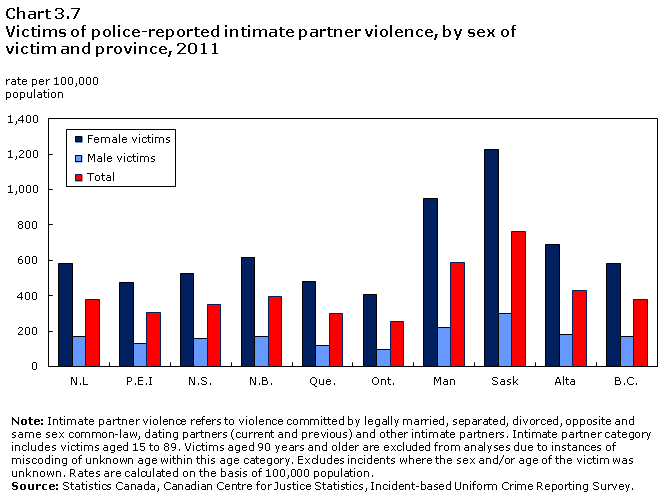
Police-reported rates of intimate partner violence tended to be higher in the territories than in the provinces. The rates in Nunavut and Northwest Territories were more than three times higher than those in any of the provinces, with rates of 4,807 victims per 100,000 population and 2,559 victims per 100,000 population, respectively. Yukon had the lowest territorial rate of 1,260 per 100,000 population, which was still 65% higher than Saskatchewan, the province with the highest rate. Regional variations in intimate partner violence against both men and women were similar.
Summary
Rates of intimate partner violence are highest among women, young people, and those in dating relationships. This is consistent with previous findings. Individuals in certain forms of intimate partner relationships were at increased risk of being killed. For instance, individuals in common-law unions were more likely to be killed than their legally married counterparts. For women, those legally separated from their spouse were more likely to be killed than those in intact marriages.
Recent rates of intimate partner homicides have been relatively stable, despite an increase in intimate partner homicides against women between 2010 and 2011. Meanwhile, the most common type of offence against intimate partners – common assault - has been declining in the last few years. This decrease was driven by a drop in assaults against women, as rates against men held steady over the same period.
Detailed data tables
Table 3.2 Victims of police-reported spousal violence, by age group and sex of victim, Canada, 2011
Table 3.3 Victims of police-reported dating violence by age group and sex of victim, Canada, 2011
Table 3.7 Victims of spousal homicides, by sex, Canada, 1991 to 2011
Table 3.8 Victims of dating homicide, by sex, Canada, 1991 to 2011
References
Brennan, S. 2011. "Self-reported spousal violence, 2009." Family Violence in Canada: A Statistical Profile. Statistics Canada Catalogue no. 85-224-X.
Busch, A.L. and M. Rosenberg. 2004. "Comparing women and men arrested for domestic violence: A preliminary report." Journal of Family Violence. Vol. 19, no. 1. p. 49-57.
Garner, J.H. and C.D. Maxwell. 2009. "Prosecution and conviction rates for intimate partner violence." Criminal Justice Review. Vol. 34, no. 1, p.44-79.
Heise L, G.-M. C. 2002. "Violence by intimate partners." In E. Krug, Dahlberg L.L., Mercy J.A., et al. (eds.). World Report on Violence and Health. World Health Organization, 2002. Geneva, Switzerland. p. 87-121. (accessed November 9, 2012).
Hotton, T. 2001. "Spousal violence after marital separation." Juristat. Vol. 21, no. 7. Statistics Canada. no. 85-002-X.
Johnson, H. 2006. Measuring Violence Against Women: Statistical Trends 2006. Statistics Canada Catalogue no. 85-570-X.
Johnson, H. and T. Hotton. 2003. "Losing control: Homicide risk in estranged and intact intimate relationships." Homicide Studies. Vol. 7, no. 1. p. 58-84.
Marshall, I. and C. Block. 2004. "Maximizing the availability of cross-national data on homicide." Homicide Studies. Vol. 8, no. 3. p. 267-310.
Sinha, M. 2012. "Family violence in Canada: A statistical profile, 2010." Juristat. Statistics Canada. no. 85-002-X.
Sinha, M. 2013. "Measuring violence against women: Statistical Trends." Juristat. Statistics Canada Catalogue no. 85-002-X.
Statistics Canada. 2012. Portrait of Families and Living Arrangements in Canada: Families, households and marital status, 2011, Census of Population. Catalogue no. 98-312-X. (accessed January 31, 2013).
Zhang, T., J. Hoddenbagh, S. McDonald and K. Scrim. 2013. An Estimation of the Economic Impact of Spousal Violence in Canada, 2009. Department of Justice Canada. Ottawa. (accessed January 31, 2013).
Notes
- This information comes from the 2009 General Social Survey on victimization, which asked Canadians about their experiences of victimization and use of services, such as police and victim services.
- For information on emotional and financial abuse against spouses, see Sinha 2013 and Brennan 2011.
- Based on previous research on intimate partner violence (Sinha 2013, Sinha 2012).
- The higher risk of dating violence exists despite the fact that the rate of dating violence is underestimated. Underestimation is a result of the inflated size of population used in the calculation of dating violence rates. That is, the calculation of a dating violence rate uses the entire population of unmarried persons, regardless of their dating relationship status. For more information, see Text box 3.1
- According to police-reported data, 28% of victims of dating partners were living together at the time of the incident. This can include those with short-term or temporary living arrangements. The proportion of dating violence victims living together ranges from a low of 8% in Quebec to a high of 45% in Nunavut.
- Rates of dating homicides, while higher for women in most age groups, were greater for men than women starting at age 55. This may be explained by the much lower population of widowed men aged 55 years and older compared to widowed women (1.6 million versus 6.3 million). That is, the smaller population of widowed men (smaller population at risk) results in older men's higher prevalence rate per 100,000 unmarried persons.
- Percentages do not total 100%, as 'other intimate partner' relationships account for 1% of all intimate partner victims. It is unknown whether these other relationships were intact or had terminated.
- Controlling for differences in the size of the marital population using the Incident-based Crime Reporting Survey is not possible, due to differences between relationship categories in this survey and population data.
- See Text box 3.1 for more information on calculating rates of intimate partner violence.
- Excludes common-law spouses, since population data do not exist for previous common-law partners. Also excludes homicides committed by same-sex spouses and ex-same-sex spouses, as there are no population data specifically for these groups.
- Since the Incident-based UCR Survey captures common-law and legally married victims in the category of 'spouse', it is not possible to distinguish between common-law and married victims for violent crime overall.
- Overall, incidents involving weapons were more likely than those involving physical force to result in physical injury (67% versus 64%). In addition, male victims were more likely than female victims to sustain injury when a weapon was used (74% versus 64%), though female victims were more often injured when the incident involved the use of physical force (64% versus 61% of male victims).
- Some jurisdictions also require consideration of whether it is in the public interest to lay charges.
- For incidents of intimate partner violence, police services in Ontario do not have the ability to clear an incident otherwise. These police services must either charge or not clear the incident.
- See Marshall and Block 2004.
- Data on homicides between dating partners are not available prior to 1991. The Homicide Survey was revised and expanded in 1991 in an effort to respond to changing information needs.
- Analysis of the three-year trend database is limited to only those offences that have complete victim records and where UCR offence classification has remained constant over the three-year period.
- According to the General Social Survey on Victimization, reporting rates to police for incidents of spousal violence against women fell from 36% in 2004 to 30% in 2009, the last time the survey was conducted.
- Date modified: